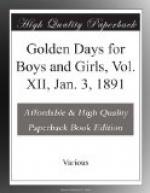If your negative is a thin one, a diffused light is better for printing than the direct rays of the sun. Diffused light is a strong light that is not sunlight.
If the negative is exceedingly thin, the light indoors, away from the window, will be sufficient. Satisfactory results cannot of course be achieved with too thin a negative, but this diffused light will give the best print that you can obtain.
In examining the print from time to time be sure that you do not open both sides of the printing frame at once, for if you should do this, you will find it impossible to replace the print in exactly the same position, and so it will be spoiled by being printed with double lines.
No exact rule can be given for the length of time which should be allowed for the printing of a negative. It should, however, be allowed to become twice as dark as it ought to be after the picture is toned and mounted. The after processes of toning bleach the print very much, as the amateur will discover for himself.
If a negative is very dense or thick, as over-development will sometimes cause it to become, the time for printing will be considerably extended. While in a good light, with a negative of the right density, five minutes or less is sufficient to print a negative, three or four hours will sometimes be required.
When the print has become dark enough, it should be removed from the printing frame and put at once in a dark place where the light cannot reach it. It is what is known as a proof at this stage, and the light will turn it black.
About twenty prints can be toned at once, and, as it is a long process, it is better to wait until several have accumulated than to go through the various operations with only one or two prints.
They should first be trimmed to the required size. Some amateurs leave the trimming until after they have finished the toning process, but this is not advisable for several reasons. In the first place, it is easier to trim them beforehand, because they lie flat and are not curled up, as they generally are after toning. None of the toning solution is wasted in toning the parts that are of no use, and if the accumulated clippings are saved, they are of some value on account of the silver in them.
The trimming cannot be satisfactorily done with a pair of scissors, as it is impossible to cut perfectly straight. A thick piece of glass called a cutting mould is used, and a convenient little instrument called Robinson’s trimmer. If you do not wish to go to the expense of these articles, however, you can manage very well by using a sharp pen-knife to cut with and any piece of glass with straight edges to trim by.
You should have a firm, hard substance to cut on (glass is preferable), and on this should be put a piece of paper. Upon this paper the print should be laid face downward, and after you have decided how much of it you are going to cut away, draw your knife firmly along by the edge of the glass, pressing down well, and the strips will be cut off leaving a smooth, straight edge.




